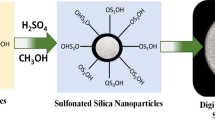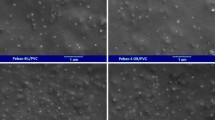Abstract
Currently, composite membranes play a significant role in the separation of acidic gases. Inorganic nanoparticles are used in these composite membranes to enhance the thermal and chemical properties of composites. In this study, polysulfone–polyethylene glycol/silica (PSF–PEG/silica) nanocomposite membranes were investigated for the purpose of improvement of the N2, O2, CH4 and CO2 separation properties. The results of gas permeability in nanocomposite membranes showed that the PSF/PEG 10,000 membrane, with 20 wt% of silica, provided the best gas separation properties. CO2 permeability in the nanocomposite membrane with 20 wt% of silica was 13.36 Barrer. In addition, the ideal selectivity for CO2/N2 paired gases in this membrane was 45.76, which was higher than the values obtained in the pure PSF membrane and the composite membrane with 20 wt% PEG 10,000. In addition, scanning electron microscopy, infrared spectroscopy, thermal gravimetric analysis, X-ray diffraction, differential scanning calorimetry and a tensile strength test were all used to examine the membrane structure and morphology of the nanocomposite. Finally, mechanical rheometry was used to study the rheological properties of hybrid nanosized composites and the effect of nanoparticle percentage on them.














Similar content being viewed by others
References
Ahn J, Chung W-J, Pinnau I, Guiver M (2008) Polysulfone/silica nanoparticle mixed-matrix membranes for gas separation. J Membr Sci 314(1):123–133
Arya A, Sharma A (2018) Effect of Salt concentration on dielectric properties of Li-ion conducting blend polymer electrolytes. J Mater Sci: Mater Electron. https://doi.org/10.1007/s10854-018-9905-3
Basu S, Odena A, Vankelecom I (2010) Asymmetric matrimid®/[Cu3(BTC)2] mixed-matrix membranes for gas separations. J Membr Sci 362:478–487. https://doi.org/10.1016/j.memsci.2010.07.005
Bicerano J, Douglas JF, Brune DA (1999) Model for the viscosity of particle dispersions. J Macromol Sci Part C 39(4):561–642
Bos A, Pünt I, Wessling M, Strathmann H (1999) CO2-induced plasticization phenomena in glassy polymers. J Membr Sci 155:67–78
Cassagnau P (2008) Melt rheology of organoclay and fumed silica nanocomposites. Polymer 49:2183–2196
Cassagnau P, Melis F (2003) Non-linear viscoelastic behaviour and modulus recovery in silica filled polymers. Polymer 44:6607–6615
Chiou JS, Maeda Y, Paul DR (1987) Gas permeation in polyethersulfone. J Appl Polym Sci 33:1823–1828. https://doi.org/10.1002/app.1987.070330533
Corrado T, Guo R (2020) Macromolecular design strategies toward tailoring free volume in glassy polymers for high performance gas separation membranes. Mol Syst Des Eng 5(1):22–48
Dong G, Li H, Chen V (2013) Challenges and opportunities for mixed-matrix membranes for gas separation. J Mater Chem A 1:4610–4630. https://doi.org/10.1039/C3TA00927K
Douglas JF, Garboczi EJ (1995) Intrinsic viscosity and the polarizability of particles having a wide range of shapes. Adv Chem Phys 91:85–154
Elias L, Fenouillot F, Majesté J-C, Alcouffe P, Cassagnau P (2008) Immiscible polymer blends stabilized with nano-silica particles: rheology and effective interfacial tension. Polymer 49:4378–4385
Elias L, Fenouillot F, Majesté J-C, Cassagnau P (2007) Morphology and rheology of immiscible polymer blends filled with silica nanoparticles. Polymer 48:6029–6040
Fu S-Y, Sun Z, Huang P, Li Y-Q, Hu N (2019) Some basic aspects of polymer nanocomposites: a critical review. Nano Mater Sci. https://doi.org/10.1016/j.nanoms.2019.02.006
Ge L, Zhu Z, Rudolph V (2011) Enhanced gas permeability by fabricating functionalized multi-walled carbon nanotubes and polyethersulfone nanocomposite membrane. Sep Purif Technol 78:76–82
Haghtalab A, Marzban R (2011) Viscoelastic properties of nanosilica-filled polypropylene in the molten state: effect of particle size. Adv Polym Technol 30:203–218
Hatami A, Salahshoori I, Rashidi N, Nasirian D (2019) The effect of ZIF-90 particle in Pebax/PSF composite membrane on the transport properties of CO2, CH4 and N2 gases by molecular dynamics simulation method. Chin J Chem Eng. https://doi.org/10.1016/j.cjche.2019.12.011
Heidari A, Heidari N, Godarzvand Chegini M, Amiri R, Khademi Jahromi F, Ghorbani M (2012) A new method for synthesis of nanocomposite membranes for separation of gases. Adv Sci Lett. https://doi.org/10.1166/asl.2012.2176
Heidary M, Jafari SH, Khonakdar HA, Wagenknecht U, Heinrich G, Boldt R (2013) Effect of end-capped nanosilica on mechanical properties and microstructure of LLLDPE/EVA blends. J Appl Polym Sci 127:1172–1179. https://doi.org/10.1002/app.37583
Hoffmann B, Dietrich C, Thomann R, Friedrich C, Mülhaupt R (2000) Morphology and rheology of polystyrene nanocomposites based upon organoclay. Macromol Rapid Commun 21:57–61
Huang X, Fang X, Lu Z, Chen S (2009) Reinforcement of polysiloxane with superhydrophobic nanosilica. J Mater Sci 44:4522–4530
Jeffrey DJ, Acrivos A (1976) The rheological properties of suspensions of rigid particles. AIChE J 22:417–432
Jiang L, Lam Y, Tam K, Chua T, Sim G, Ang L (2005) Strengthening acrylonitrile-butadiene-styrene (ABS) with nano-sized and micron-sized calcium carbonate. Polymer 46:243–252
Jiang L, Zhang J, Wolcott MP (2007) Comparison of polylactide/nano-sized calcium carbonate and polylactide/montmorillonite composites: reinforcing effects and toughening mechanisms. Polymer 48:7632–7644
Jiang LY, Chung TS, Rajagopalan R (2007) Matrimid®/MgO mixed matrix membranes for pervaporation. AIChE J 53:1745–1757
Joly C, Goizet S, Schrotter J-C, Sanchez Marcano J, Escoubes M (1997) Sol–gel polyimide-silica composite membrane: gas transport properties. J Membr Sci 130(1):63–74
Kaniappan K, Latha S (2011) Certain investigations on the formulation and characterization of polystyrene/poly(methyl methacrylate) blends. Int J ChemTech Res 3:708–715
Khonakdar H (2015) Dynamic mechanical analysis and thermal properties of LLDPE/EVA/modified silica nanocomposites. Compos Part B Eng 76:343–353. https://doi.org/10.1016/j.compositesb.2015.02.031
Khosravi T, Mosleh S, Bakhtiari O, Mohammadi T (2012) Mixed matrix membranes of Matrimid 5218 loaded with zeolite 4A for pervaporation separation of water–isopropanol mixtures. Chem Eng Res Des 90:2353–2363
Kim JH, Lee YM (2001) Gas permeation properties of poly(amide-6-b-ethylene oxide)–silica hybrid membranes. J Membr Sci 193:209–225. https://doi.org/10.1016/S0376-7388(01)00514-2
Li W, Karger-Kocsis J, Schlarb AK (2009) Dispersion of TiO2 particles in PET/PP/TiO2 and PET/PP/PP-g-MA/TiO2 composites prepared with different blending procedures. Macromol Mater Eng 294:582–589
Li Y, Guan H-M, Chung T-S, Kulprathipanja S (2006) Effects of novel silane modification of zeolite surface on polymer chain rigidification and partial pore blockage in polyethersulfone (PES)–zeolite a mixed matrix membranes. J Membr Sci 275:17–28
Lipatov YS, Nesterov A, Ignatova T, Nesterov D (2002) Effect of polymer–filler surface interactions on the phase separation in polymer blends. Polymer 43:875–880
Lipatov YS, Shumsky V, Getmanchuk I, Gorbatenko A (1982) Rheology of polymer blends. Rheol Acta 21:270–279
Manatunga D, de Silva R, De Silva KM (2015) Double layer approach to create durable superhydrophobicity on cotton fabric using nano silica and auxiliary non fluorinated materials. Appl Surf Sci. https://doi.org/10.1016/j.apsusc.2015.11.068
Mannan HA, Mukhtar H, Murugesan T, Nasir R, Mohshim DF, Mushtaq A (2013) Recent applications of polymer blends in gas separation membranes. Chem Eng Technol 36:1838–1846. https://doi.org/10.1002/ceat.201300342
Mascia L, Lavorgna M (2012) Nanostructured polymer composites by sol–gel method. Wiley encyclopedia of composites. Wiley, Hoboken. https://doi.org/10.1002/9781118097298.weoc158
Meera A, Said S, Grohens Y, Thomas S (2009) Nonlinear viscoelastic behavior of silica-filled natural rubber nanocomposites. J Phys Chem C 113:17997–18002
Moaddeb M, Koros WJ (1996) Effects of colloidal silica incorporation on oxygen/nitrogen separation properties of ceramic-supported 6FDA-IPDA thin films. J Membr Sci 111:283–290. https://doi.org/10.1016/0376-7388(95)00253-7
Moaddeb M, Koros WJ (1997) Gas transport properties of thin polymeric membranes in the presence of silicon dioxide particles. J Membr Sci 125:143–163. https://doi.org/10.1016/S0376-7388(96)00251-7
Münstedt H, Köppl T, Triebel C (2010) Viscous and elastic properties of poly (methyl methacrylate) melts filled with silica nanoparticles. Polymer 51:185–191
Nasirian D, Salahshoori I, Sadeghi M, Rashidi N, Hassanzadeganroudsari M (2019) Investigation of the gas permeability properties from polysulfone/polyethylene glycol composite membrane. Polym Bull. https://doi.org/10.1007/s00289-019-03031-3
Nazockdast E, Nazockdast H, Goharpey F (2008) Linear and nonlinear melt-state viscoelastic properties of polypropylene/organoclay nanocomposites. Polym Eng Sci 48:1240–1249
Nistor C, Shishatskiy S, Popa M, Nunes SP (2009) Organic–inorganic CO2 selective membranes prepared by the sol–gel process separation. Sci Technol 44:3392–3411. https://doi.org/10.1080/01496390903212698
Osman MA, Atallah A (2006) Effect of the particle size on the viscoelastic properties of filled polyethylene. Polymer 47:2357–2368
Pandey P, Chauhan RS (2001) Membranes for gas separation. Prog Polym Sci 26:853–893. https://doi.org/10.1016/S0079-6700(01)00009-0
Park HB, Lee YM (2008) Polymeric membrane materials and potential use in gas separation. Adv Membr Technol Appl. https://doi.org/10.1002/9780470276280.ch24
Pourafshari Chenar M, Rajabi H, Pakizeh M, Sadeghi M, Bolverdi A (2013) Effect of solvent type on the morphology and gas permeation properties of polysulfone–silica nanocomposite membranes. J Polym Res 20:216. https://doi.org/10.1007/s10965-013-0216-3
Rafiq S, Mana Z, Maulud A, Muhammad N, Maitra S (2012) Separation of CO2 from CH4 using polysulfone/polyimide silica nanocomposite membranes. Sep Purif Technol 90:162–172
Rao BG, Mukherjee D, Reddy BM (2017) Chapter 1—novel approaches for preparation of nanoparticles. In: Ficai D, Grumezescu AM (eds) Nanostructures for novel therapy. Elsevier, Amsterdam, pp 1–36. https://doi.org/10.1016/b978-0-323-46142-9.00001-3
Runt J, Huang J (2002) Chapter 8—polymer blends and copolymers. In: Cheng SZD (ed) Handbook of thermal analysis and calorimetry, vol 3. Elsevier, Amsterdam, pp 273–294. https://doi.org/10.1016/s1573-4374(02)80011-5
Sadeghi M, Khanbabaei G, Dehaghani AHS, Sadeghi M, Aravand MA, Akbarzade M, Khatti S (2008) Gas permeation properties of ethylene vinyl acetate–silica nanocomposite membranes. J Membr Sci 322:423–428. https://doi.org/10.1016/j.memsci.2008.05.077
Sadeghi M, Mehdi Talakesh M, Ghalei B, Shafiei M (2013) Preparation, characterization and gas permeation properties of a polycaprolactone based polyurethane–silica nanocomposite membrane. J Membr Sci 427:21–29. https://doi.org/10.1016/j.memsci.2012.07.036
Sadeghi M, Semsarzadeh MA, Barikani M, Pourafshari Chenar M (2011) Gas separation properties of polyether-based polyurethane–silica nanocomposite membranes. J Membr Sci 376:188–195. https://doi.org/10.1016/j.memsci.2011.04.021
Sadeghi M, Semsarzadeh MA, Moadel H (2009) Enhancement of the gas separation properties of polybenzimidazole (PBI) membrane by incorporation of silica nano particles. J Membr Sci 331:21–30. https://doi.org/10.1016/j.memsci.2008.12.073
Saffar A, Jalali Dil E, Carreau PJ, Ajji A, Kamal MR (2016) Phase behavior of binary blends of PP/PP-g-AA: limitations of the conventional characterization techniques. Polym Int 65:508–515. https://doi.org/10.1002/pi.5082
Kentish SE, Scholes CA, Stevens GW (2008) Carbon dioxide separation through polymeric membrane systems for flue gas applications. Recent Patents Chem Eng 1(1):52–66
Semsarzadeh MA, Ghalei B (2012) Characterization and gas permeability of polyurethane and polyvinyl acetate blend membranes with polyethylene oxide–polypropylene oxide block copolymer. J Membr Sci 401–402:97–108. https://doi.org/10.1016/j.memsci.2012.01.035
Setiawan WK, Chiang K-Y (2019) Silica applied as mixed matrix membrane inorganic filler for gas separation: a review. Sustain Environ Res 29:32
Singh LP, Agarwal SK, Bhattacharyya S, Sharma U, Ahalawat S (2011) Preparation of silica nanoparticles and its beneficial role in cementitious materials. Nanomater Nanotechnol. https://doi.org/10.5772/50950
Sridhar S, Smitha B, Aminabhavi TM (2007) Separation of carbon dioxide from natural gas mixtures through polymeric membranes—a review. Sep Purif Rev 36:113–174. https://doi.org/10.1080/15422110601165967
Sternstein S, Zhu A-J (2002) Reinforcement mechanism of nanofilled polymer melts as elucidated by nonlinear viscoelastic behavior. Macromolecules 35:7262–7273
Sun S, Li C, Zhang L, Du H, Burnell-Gray J (2006) Effects of surface modification of fumed silica on interfacial structures and mechanical properties of poly (vinyl chloride) composites. Eur Polym J 42:1643–1652
Thareja P, Velankar S (2008) Rheology of immiscible blends with particle-induced drop clusters. Rheol Acta 47:189–200
Uemura T et al (2015) Mixing of immiscible polymers using nanoporous coordination templates. Nat Commun 6:7473. https://doi.org/10.1038/ncomms8473
Yang H-C, Hou J, Chen V, Xu Z-K (2016) Surface and interface engineering for organic–inorganic composite membranes. J Mater Chem A 4:9716–9729. https://doi.org/10.1039/C6TA02844F
Yang H et al (2008) Rheology and phase structure of PP/EPDM/SiO2 ternary composites. Eur Polym J 44:113–123
Yao X et al (2009) Interface structure of poly (ethylene terephthalate)/silica nanocomposites. Polymer 50:1251–1256
Zhang Q, Archer LA (2002) Poly (ethylene oxide)/silica nanocomposites: structure and rheology. Langmuir 18:10435–10442
Zhong Y, Wang S-Q (2003) Exfoliation and yield behavior in nanodispersions of organically modified montmorillonite clay. J Rheol 47:483–495
Acknowledgements
The authors are thankful to Dr. M. Sadeghi (Isfahan University of Technology, Chemical Engineering Faculty, Isfahan, Iran) for encouraging them to carry out the work.
Funding
No funding source was available for this research.
Author information
Authors and Affiliations
Contributions
Iman Salahshoori, Ali Hatami contributed to conceptualization and methodology; Danial Nasirian, Iman Salahshoori, Niloufar Rashidi, Majid Hassanzadeganroudsari contributed to formal analysis and investigation; Niloufar Rashidi, Iman Salahshoori helped in writing—original draft preparation; Md Kamal Hossain, Ali Hatami contributed to writing—review, data analysis and editing; Majid Hassanzadeganroudsari helped in resources, supervision and writing—review and editing.
Corresponding author
Ethics declarations
Conflict of interest
The authors declare that they have no conflict of interest.
Additional information
Publisher's Note
Springer Nature remains neutral with regard to jurisdictional claims in published maps and institutional affiliations.
Rights and permissions
About this article
Cite this article
Salahshoori, I., Nasirian, D., Rashidi, N. et al. The effect of silica nanoparticles on polysulfone–polyethylene glycol (PSF/PEG) composite membrane on gas separation and rheological properties of nanocomposites. Polym. Bull. 78, 3227–3258 (2021). https://doi.org/10.1007/s00289-020-03255-8
Received:
Revised:
Accepted:
Published:
Issue Date:
DOI: https://doi.org/10.1007/s00289-020-03255-8




